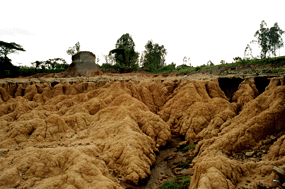Erosion and soil erosion
The intensity of erosion by water is determined by the amount of surface runoff available and the given energy.
Potential Erosion Risk
The processes generating surface runoff determine the potential erosion risk. These processes are dependent on a variety of factors which are interacting in a multidimensional and non-linear relationship (Schütt and Thiemann 2001).
Actual Erosion Risk
Human activities such as agriculture affect erosional processes which are then summed up to soil erosion.In general, soil erosion shows an increased intensity compared to natural erosion processes. Human impact causes a reduction of natural vegetation cover or even complete destruction (Schütt and Thiemann 2001). If vegetation is reduced the amount of precipitation which is intercepted and evapotranspirated decreases and no natural barrier holds up the downward moving water. This results in a higher proportion of precipitation which runs unhampered on the surface downslope causing, rill or gully erosion. This is aggravated if the soil is compacted by human and animal activities. Soil compaction reduces the infiltration rate. The splash effect is also higher if the protecting vegetation cover is lacking which causes sheet erosion (Richter 1998). Soil erosion risk increases.
However, positive effects can arise from human activities such as practicing soil and water conservation measures (Schütt and Thiemann 2001).
These interactions of land use, vegetation cover and soil erosion risk are important to understand in order to prevent soil erosion and its damaging impacts. These can be found not only in the immediate surrounding (on-site damages) but also in downstream areas of the watershed (off-site damages). This is an important reason for tackling the problems by the Watershed Management approach.
More information about soil erosion and soil erosion tyoes you can gain if you follow the hyperlink which will lead you to the Soil Erosion-Module of this e-Learning environment.
Soil erosion in the Gina River catchment
The characteristics of the factors determining soil erosion in the Gina River catchment (e.g. steep slopes, intense agricultural activities) determine that soil erosion is the predominant morphological process in the drainage basin (see figure). High rates of population growth cause a high pressure on the soil resources to meet the demand for food. Extension and intensifying of agricultural activities and inappropriate or not sufficient soil conservation measures result in processes of soil erosion. The eroded material is transported downslope and is deposited on lower parts of the slope where inclination decreases (e.g., as a fan) or enters the river.
The assessment of soil erosion risk in the Gina River catchment as a basis for concepts to a more sustainable resource use is topic in ‘landscape sensitivity’. Measures to prevent soil erosion are described in ‘soil and water conservation measures’.
As well as soil erosion processes mass movements are dominant in the Gina River catchment.
